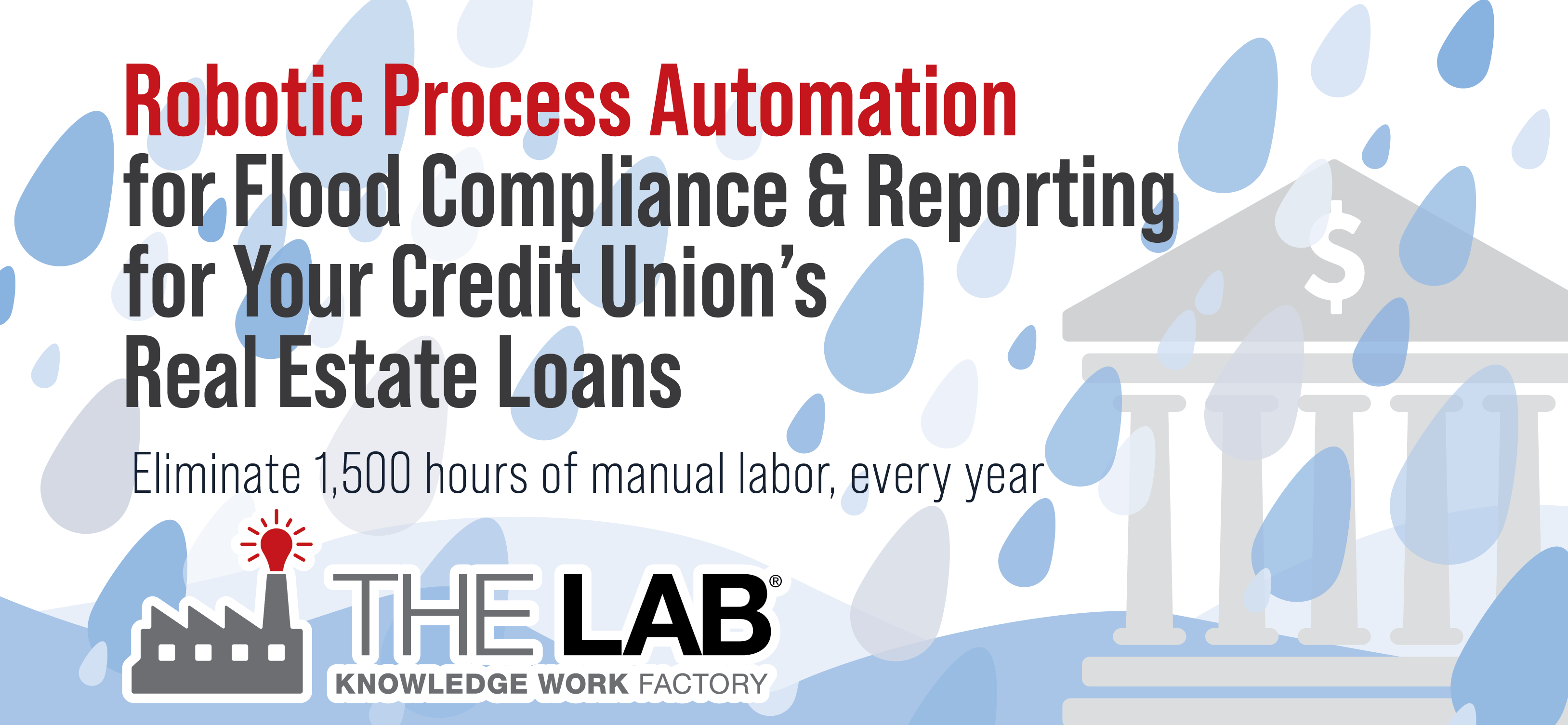RPA credit union bots can eliminate 500 to 2,000 hours of manual labor, every year
Updating flood information for real-estate loans is a flood of work for any credit union.
Every day, it involves a ton of manual, sit-at-the-computer labor. It requires that your credit union’s Business Analysts pull lots of data from lots of disparate sources, and then stare-and-compare for things like expiring flood-insurance policies and paid-off flood loans.
These “disparate sources” include websites from your credit union’s flood-insurance carrier… your master flood data compliance system… your loan-origination system… and others. It also means working in applications like Excel. And it entails finding the exceptions that require follow-up.
This is a huge amount of work; a typical regional credit union must spend about six hours a day, every day, just for flood reporting!
Fortunately, it’s now possible to automate this tedious process with RPA, or robotic process automation, bots from The Lab, North America’s credit union-automation authority.
Bots are faster than people. They don’t make mistakes or take breaks. They certainly don’t mind doing boring, tedious work. But just like people, they can “sit at the computer” and “swivel-chair” their way through lots of disparate applications that don’t talk to each other, eliminating the need for the “human glue” your credit union currently uses to connect them all.
In this article, we’ll walk you through a typical bot as it powers its way through flood report reconciliations. We’ve also created an accompanying video for this article, which you can view right here:

We want to be perfectly clear: Although the bot in this example—from a real credit union client of The Lab’s—is using systems specific to that credit union, bots from The Lab can work with whatever systems your credit union uses, with no need to change core platforms or data structures!
In the example shown in the video, the bot starts by logging in to CoreLogic “FloodCert,” a third-party automated flood-determination and compliance-management system. Just like a person, it has its own login and password. Once inside the system, it searches for and downloads the reports it needs.
Next, it logs into the credit union’s flood insurance carrier’s website. Again, bots from The Lab can access any carrier; in this example, the carrier is Lee & Mason.
Once it’s in the system, it searches for the New Properties Report and downloads it.
Then it switches to the credit union’s own SharePoint site, where it downloads the “ServiceLink Reports” and “Flood Worksheets,” and saves them an Excel sheet to the credit union’s network drive.
Meanwhile, it also saves the CoreLogic “Daily Origination” report, as well as the Lee & Mason report, both as Excel sheets.
Why all the different Excel sheets? This is how the bot will perform the reconciliation! It literally parks the different spreadsheets—with either the credit union’s internal master-flood data or the reporting sites’ data—side-by-side, and compares them. Using Excel’s “Spreadsheet Compare” function, it searches all the files, row by row, and even cell by cell, to find any differences and discrepancies.
It then exports its results, as an Exception Report, and uploads it to the credit union’s SharePoint drive (incidentally, in just the right folder, with just the right rational filename).
The report, conveniently, has different tabs for easy navigation:
- One shows the expired policies
- Another shows the paid-off loans
- Another reveals the update on the CoreLogic daily flood status
- Another shows any discrepancies found from the ServiceLink monthly report
- The last tab shows its findings from the ServiceLink daily report
Is it done? Not quite. It also emails its report to the credit union’s Flood Team. So all they need to do at this point is follow up on the few exceptions which the bot uncovered for them.

Parking a bot atop atop this tedious chore not only saves time—as we’ll detail momentarily. It also improves information security, because all credentials are encrypted and safely stored in a virtual vault.
So how much does this one bot save?
Well, it takes a person at this credit union six hours a day, every day, to search through all of these systems and maintain an audit trail and spotlight discrepancies which require intervention. With the bot, it’s 100-percent automated, to the tune of 1,500 hours of labor eliminated each year, every year… forever.
Most importantly, the bot saves more than time. It saves people. Humans absolutely hate doing tedious computer work like this; it’s a big factor in credit union employee turnover. But now, thanks to the bot, this credit union is making its staffers feel more valued, as they get to work on more fulfilling activities.

Credit Union executives are turning to The Lab to accelerate automation/AI readiness, lay the groundwork for strategic end-to-end process/product innovation, and implement Robotic Process Automation (RPA) “bots” to automate dozens of processes. With as few as three RPA bots from The Lab, you, too, can begin implementing on your company-wide strategic innovation roadmap—and start seeing hard-dollar benefits within weeks.
The best way to appreciate the speed and game-changing power of the automation suites installed by The Lab is to see it for yourself. Schedule a free, no-obligation 30-minute screen-sharing demo with The Lab, and you’ll see RPA bots in action. You’ll learn how we do all this from our U.S. offices in Houston, with nothing outsourced or offshored, and get all your questions answered by our friendly experts. Hedge your company against employee turnover, eliminate errors, and put your organization on a roadmap to accelerate your automation and AI initiatives.
Simply call (201) 526-1200 or email info@thelabconsulting.com to book your demo today!

















